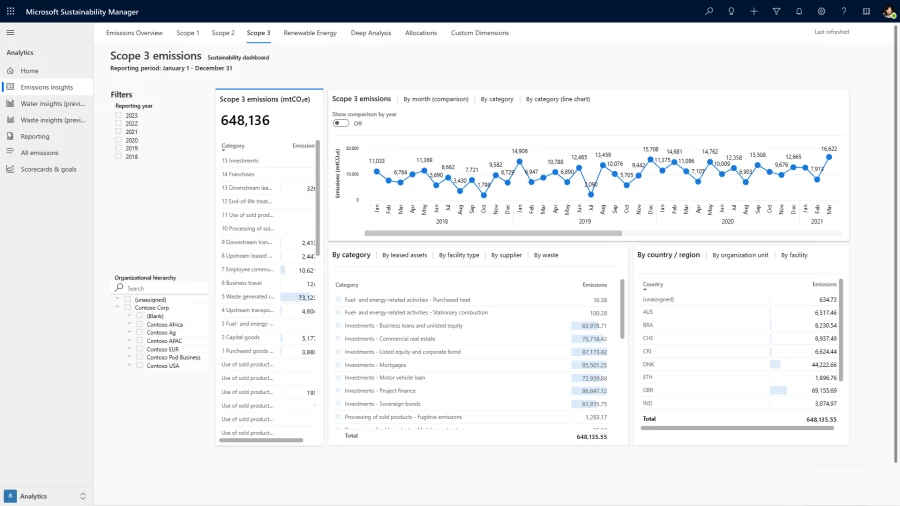
Introducing the latest ESG innovations with Microsoft Cloud for Sustainability
We launched Microsoft Cloud for Sustainability in June 2022 with a commitment to help our customers create their own operational efficiencies to reduce their environmental impact. We have made amazing progress since we launched, releasing new features every month. With Microsoft Cloud for Sustainability, we have enabled organizations to accelerate sustainability progress and business growth by bringing together environmental, social, and governance (ESG) capabilities from Microsoft and our global ecosystem of partners. Together we provide tools to customers such as Ingredion, the BBC, Grupo Bimbo, and many others to gather actionable insights needed to transform their business operations for a more sustainable future.
Hear from me, Microsoft Chief Sustainability Officer Melanie Nakagawa, and other sustainability leaders exploring the latest tech innovations helping companies address regulations.
Harnessing the power of ESG data
We understand to effectively measure and manage sustainability progress, organizations need digital technologies and data. Addressing the scale and breadth of sustainability challenges requires a data-first approach. Additionally, accurate and reliable data intelligence is critical to drive impact reduction efforts, reporting, and business transformation. Furthermore, using data to gain a holistic understanding of an organization’s sustainability footprint and value chain allows for development of more effective strategies to improve ESG performance.
Our initial release of the Microsoft Cloud for Sustainability data model focused on the pressing need to address carbon emissions. We’ve since expanded the data model to include water and waste. These data models centralize data to help streamline data ingestion, sharing, calculations, and reporting. This includes data from across the enterprise—enterprise resource planning (ERP) data, plant data, the Internet of Things (IoT) sensor data, telemetry at the edge—and, from external sources, too—including suppliers, utility companies, transportation, and more.
To enable organizations to centralize and standardize data in a comprehensive ESG data estate we are introducing, Project ESG Lake (preview in July, 2023). Like other Microsoft data manager solutions, this is an industry data platform, enabling customers, partners, and independent software vendors (ISVs) to perform analytics and build custom apps to meet their industry-specific needs. They will also be able to leverage Microsoft Fabric to analyze, define, train, score, and predict emissions. With an extensible analytical data model and integration templates, organizations can access and organize ESG data, improve data sharing and governance, and ultimately use datasets and AI models to unlock intelligence and generate actionable insights.
AI is being infused into many of our solutions to perform advanced analytics and generate detailed, actionable insights, helping customers use their data to speed up progress in their sustainability journey. We are also introducing a new anomaly detection feature coming later this year which will enable customers to find outliers, trends, and correlations between their activity data and calculated emissions through an integrated and interactive AI model.
Another AI-based capability in the works is “what-if analysis.” This will enable Microsoft Cloud for Sustainability customers and partners, to use data from both the data model as well as external sources through Project ESG Lake to derive insights and forecasts related to their sustainability goals. For example, a retail organization evaluating how to reduce sustainability impact in their supply chain, can look for a new manufacturing plant based on energy source. They can also evaluate materials emissions and waste projections based on recycled content and long-term durability. The outcome of this analysis is intended to enable organizations to improve operational and supply chain sustainability.
Ultimately these capabilities are designed to help sustainability managers, procurement officers, facility managers, and other users fine-tune decisions to drive reductions.
Addressing new CSRD regulations
Emerging regulations such as the pending Corporate Sustainability Reporting Directive (CSRD) will require large organizations and their suppliers and trading partners doing business within the European Union to be more detailed in their sustainability reporting. The disclosure guidelines include information about emissions impact and emissions reduction targets, social impact, and governance systems—including ESG risks and opportunities, both to the business and how the business impacts people and the planet. Reporting must be both quantitative and qualitative, forward-looking, and retrospective.
To accomplish this, some 50,000 impacted organizations need to quickly organize their data estates for insights and reporting. Over our year of growth, we launched capabilities to help organizations improve the collection of environmental as well as collect social and governance data to address new ESG reporting requirements.
We’re also introducing prebuilt ESG reporting templates that help customers organize and track their evidence for different ESG regulatory reporting standards, starting with CSRD. We will extend this to other regulations as they are defined and implemented by governing bodies.
Tracking across Scope 1, 2, and 3
To effectively become sustainable, organizations must reduce their greenhouse gas emissions (GHG) in every facet of their business. Greenhouse gas emissions are divided into three categories for businesses and organizations—Scope 1, 2, and 3. International regulations and GHG reduction targets require companies to cut emission across all three scopes. In addition to currently available Scope 1 and 2 calculation capabilities, Microsoft Cloud for Sustainability customers will now be able to calculate all 15 categories of Scope 3 carbon emissions across their enterprise and value chain. In July, the final five Scope 3 categories (3, 10, 11, 14, and 15) will be available in preview. Customers can also bring in precalculated emissions across all scopes and emissions categories, load their own factor libraries to tailor calculations to business needs, and maintain consistent emissions calculations and reporting over time, on top of multiple existing standards we are supporting out of the box.

The expansion of our data model to store product carbon footprint (preview) data is aligned to standards defined by the Pathfinder Framework, which creates guidelines for how product level carbon data is shared across the value chain. This data model will allow organizations to store the exact carbon footprint of a unit of a product or product stock keeping unit (SKU) from suppliers for use throughout the solution. Customers will be able to calculate their Scope 3 emissions more precisely, instead of relying on emissions estimates. It is projected that by 2026, regulations and sustainability-linked lending will require adopting product carbon footprint as a key metric.1
Moving the sustainability journey beyond carbon
Since our launch, organizations are using this flagship application to unify data intelligence and enable comprehensive, integrated, and increasingly automated sustainability management at any stage of their sustainability journey. We also recently announced water sustainability management capabilities in collaboration with Ecolab and upcoming availability of waste sustainability management capabilities (preview in July, 2023).
The water data model allows customers to track water consumption, withdrawal, and discharge. With this data model customers can gain a unified view of water sustainability data needed for water accounting, water sustainability disclosures, and compliance.
Globally, 11.2 billion tons of solid waste is collected annually, with organic waste contributing 5 percent of global greenhouse gas emissions.2 For organizations that want to lower their impact, by improving recycling, landfill, and incineration practices while complying with regulations, for example, the new waste data model (preview) can help by unifying, standardizing, and preparing their waste sustainability data.
Organizations can also make more informed decisions about suppliers based on supplier sustainability rating data from EcoVadis, the largest business sustainability ratings provider. Planned for July, 2023 the integration of EcoVadis into Microsoft Cloud for Sustainability brings their broad supplier sustainability ratings data to track how suppliers are progressing on their sustainability programs. This data considers impacts on the environment, labor and human rights, ethics, and sustainable procurement.
Increasing transparency for carbon credits
Environmental Credit Service (preview), a managed service under Microsoft Cloud for Sustainability, delivers a common infrastructure to track environmental credit provenance from creation through retirement, bringing new levels of transparency to carbon credit ecosystems. The service helps decrease time to market and increase the quality and quantity of credits by automating, simplifying, and better securing the lifecycle processes that are used by ecological project owners, verifiers, and registries—ultimately giving credit purchasers more confidence and fueling marketplace momentum.
Create new efficiencies around cloud usage
The latest Emissions Impact Dashboard for Microsoft Azure and Microsoft 365 helps organizations track Scope 3 carbon emissions related to the use of these cloud services. It enables Microsoft customers to quantify the impact of Azure services on their environmental footprint and estimated emissions from on-premises alternatives. It also tracks greenhouse gas emissions associated with an organization’s use of Microsoft 365 cloud services, like sending emails through Exchange Online, storing files in SharePoint, and joining Microsoft Teams meetings.
Both of these solutions are available through Microsoft Cloud Solution Center.
A global effort with partners
Foundational to our success with our Microsoft Industry Cloud solutions is the collaboration and work we accomplish with our global ecosystem of partners. In February, 2023 we highlighted the great work from some of our system integrators and ISVs. Trusted advisers like Accenture, Avanade, Capgemini, EY, KPMG, and PwC are helping organizations everywhere plan, design, and implement strategies and robust solutions to enable transformation. While other partners are building companion solutions on top of Microsoft Cloud for Sustainability.
Along with EcoVadis, another initiative this year was related to water sustainability capabilities within Microsoft Sustainability Manager in collaboration with Ecolab. Our joint solution with Ecolab, a global sustainability leader in water, hygiene, and infection prevention, combines the power of the ECOLAB3D™ digital platform with Microsoft Sustainability Manager. With this solution, organizations are able to monitor and manage water data so they can gain greater visibility into how they are tracking water and sustainability goals.
Most recently we also shared that we are building a catalog of prebuilt and custom data connectors from third-party providers. One of our priorities is pre-built connectors that aggregate data across key emission categories to scale benefits to customers. We are also enabling custom connectors that address more specific data scenarios to be built, using an in-app experience for importing data. Arcadia, Seeq, Johnson Controls, Cognite, and Mesa are just a few of the ISVs with whom we’re partnering.
Learn more
- Try Microsoft Cloud for Sustainability first-hand with a trial.
- Get news and updates. With regulations growing, we’re quickly innovating around ESG tracking and reporting. Sign up to receive email updates.
- Learn more about the latest Microsoft Cloud for Sustainability feature releases.
Microsoft Cloud for Sustainability
Take the next steps on your sustainability journey.

1IDC FutureScape: Worldwide Manufacturing 2023 Predictions, IDC.
2Chapter 16 – Economic evaluation of solid waste management and wastewater management, ScienceDirect.




